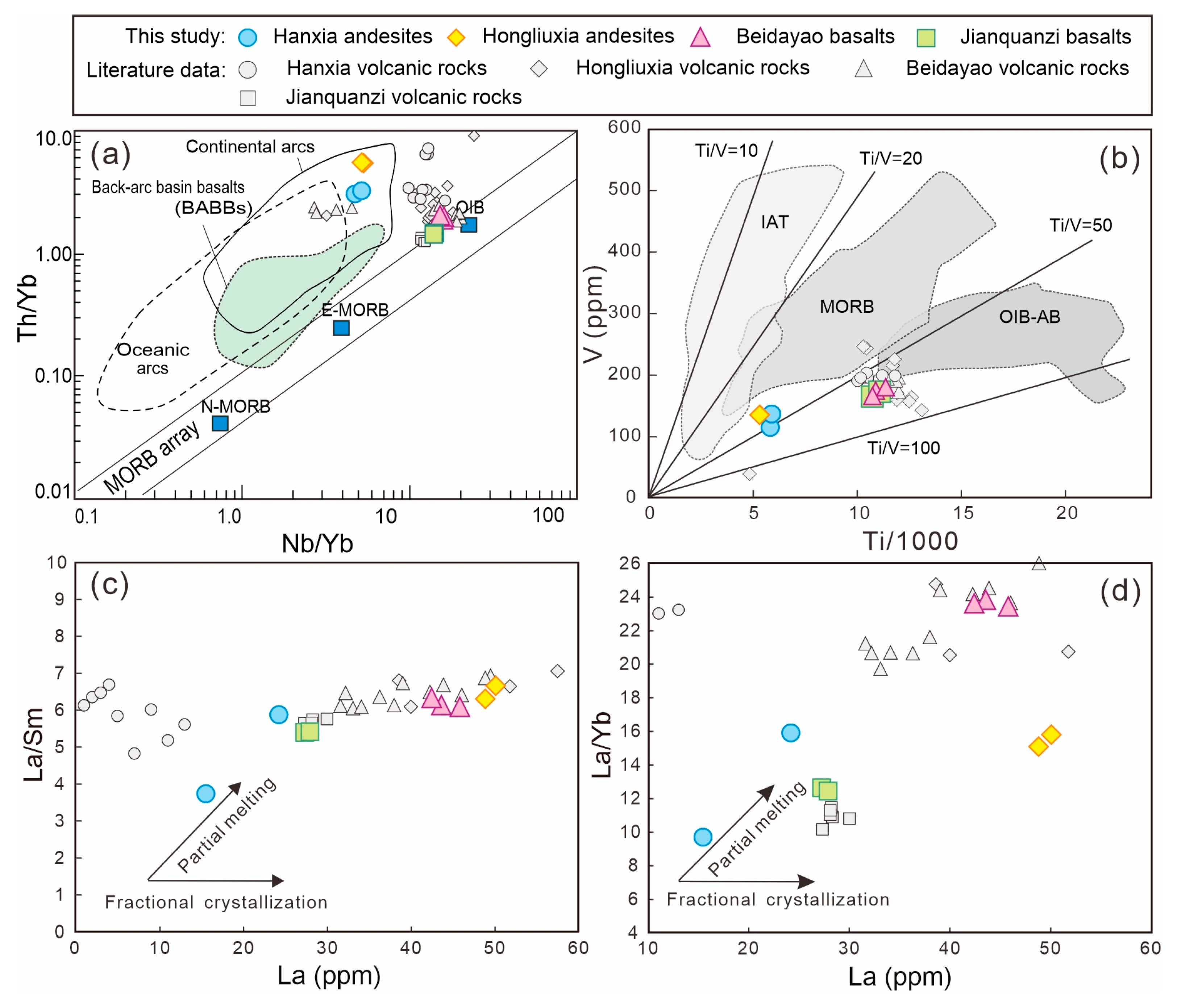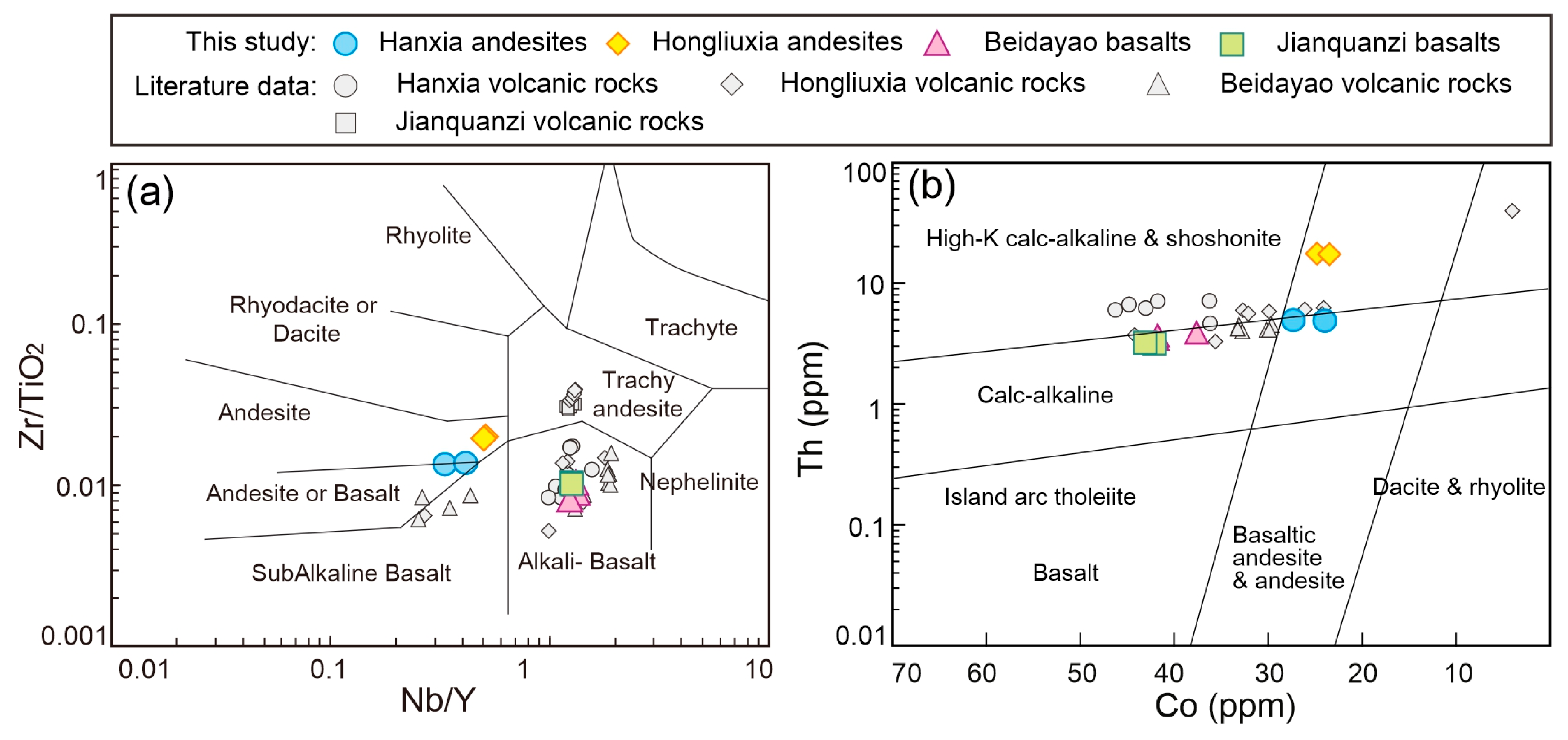The Early Cretaceous High-Nb Basalt and Arc Andesite Association in the Eastern Segment of the Altyn Tagh Fault: Petrological Records of Intracontinental Extension
Abstract
1. Introduction
2. Geological Background and Samples
3. Analytical Methods
3.1. LA-ICP-MS Zircon U–Pb Dating
3.2. Whole-Rock Major and Trace Element Analysis
3.3. Whole-Rock Sr-Nd Isotope Analysis
4. Results
4.1. Geochronology
4.2. Whole-Rock Geochemistry
4.3. Whole-Rock Sr-Nd Isotope Geochemistry
5. Discussion
5.1. Spatiotemporal Distribution of Volcanic Rocks in the Altyn Tagh Fault
5.2. Origin and Formation Mechanisms of Basalt
5.2.1. Crustal Contamination and Fractional Crystallization of Basalt
5.2.2. Magma Source Regions of Basalt
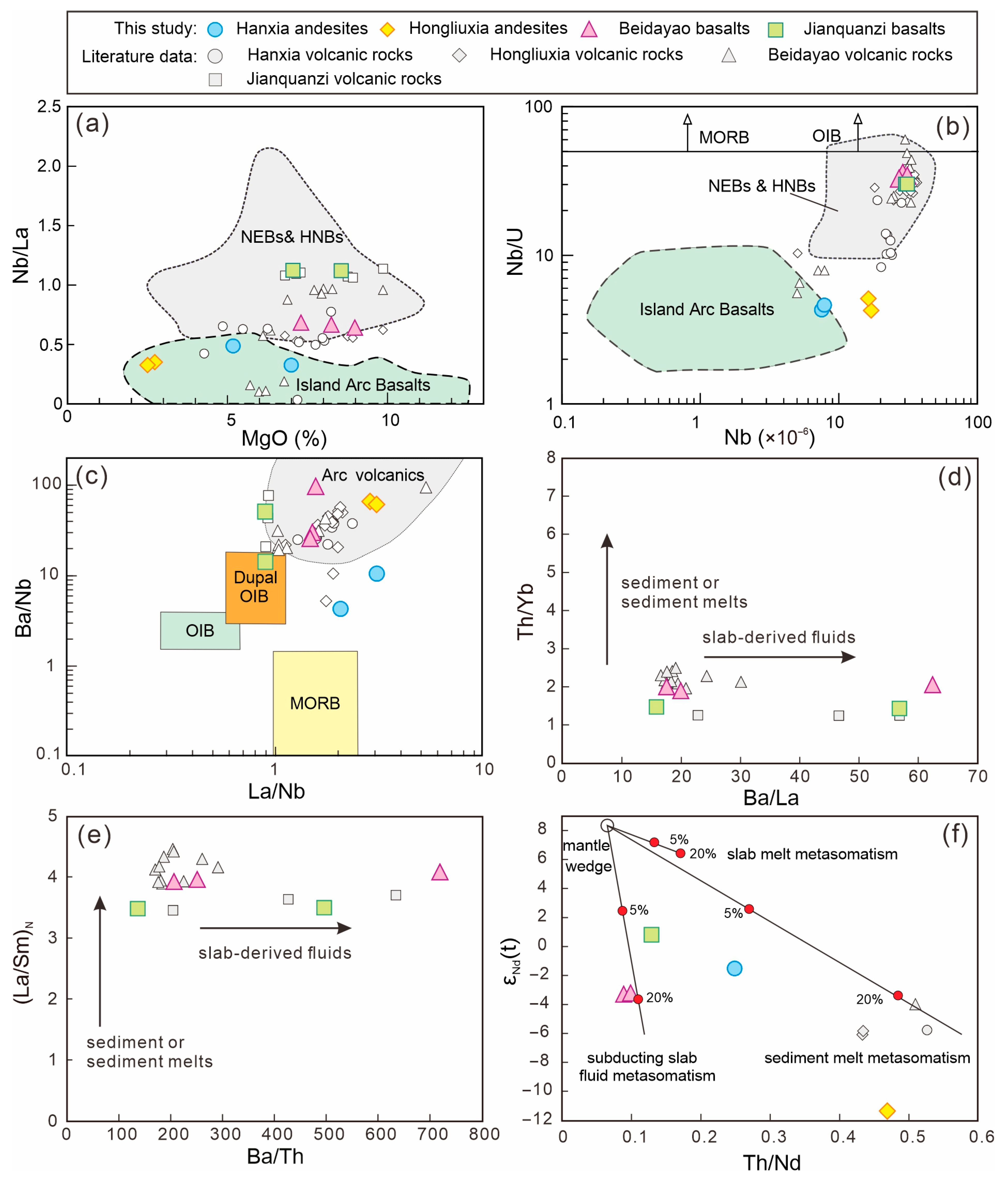
5.3. Origin and Formation Mechanisms of Andesite
5.3.1. Crustal Contamination and Fractional Crystallization of Andesite
5.3.2. Magma Source Regions of Andesite
5.4. Tectonic Implications
6. Conclusions
- LA-ICP-MS zircon U-Pb dating results indicate that the volcanic rocks in the Hongliuxia area of the Jiuxi Basin erupted during the Early Cretaceous (106.6 ± 0.6 Ma).
- The OIB-type geochemical signature observed in the Nb-enriched basalts (Nb > 20 ppm) from Jianquanzi and Beidayao in the western study area is interpreted as originating from partial melting of an enriched mantle wedge, which was metasomatized by slab-derived fluids with a contribution from the asthenospheric mantle. Magmas from this source region probably underwent fractional crystallization of olivine and clinopyroxene without significant crustal contamination.
- The andesites from Hanxia and Hongliuxia in the eastern study area show trace element patterns characteristic of Continental Arc Andesites. This indicates their derivation from the partial melting of a mantle wedge that had been metasomatized by sediment-derived melts, followed by probable fractional crystallization involving olivine, clinopyroxene, and plagioclase.
- Based on a comprehensive review of regional geological evidence, we propose that the eastern Altyn Tagh Fault volcanic rocks formed in response to asthenospheric mantle upwelling. This reveals an intracontinental extensional tectonic setting, implying intense strike-slip activity along the eastern Altyn Tagh Fault segment during the Cretaceous.
Author Contributions
Funding
Data Availability Statement
Acknowledgments
Conflicts of Interest
References
- Woodcock, N.H. The role of strike-slip fault systems at plate boundaries. Philosophical Transactions of the Royal Society of London. Ser. A Math. Phys. Sci. 1986, 317, 13–29. [Google Scholar]
- Cunningham, W.D.; Mann, P. Tectonics of Strike-Slip Restraining and Releasing Bends; Geological Society: London, UK, 2007; Volume 290, pp. 1–12. [Google Scholar]
- Pirajno, F. Intracontinental strike-slip faults, associated magmatism, mineral systems and mantle dynamics: Examples from NW China and Altay-Sayan (Siberia). J. Geodyn. 2010, 50, 325–346. [Google Scholar] [CrossRef]
- Yin, A. Cenozoic tectonic evolution of Asia: A preliminary synthesis. Tectonophysics 2010, 488, 293–325. [Google Scholar] [CrossRef]
- Zuza, A.V.; Yin, A.; Lin, J.; Sun, M. Spacing and strength of active continental strike-slip faults. Earth Planet. Sci. Lett. 2017, 457, 49–62. [Google Scholar] [CrossRef]
- Wu, G.H.; Ma, B.S.; Han, J.F.; Guan, B.Z.; Chen, X.; Yang, P.; Xie, Z. Origin and growth mechanisms of strike-slip faults in the central Tarim cratonic basin, NW China. Pet. Explor. Dev. 2021, 48, 595–607. [Google Scholar] [CrossRef]
- Crider, J.G.; Peacock, D.C. Initiation of brittle faults in the upper crust: A review of field observations. J. Struct. Geol. 2004, 26, 691–707. [Google Scholar] [CrossRef]
- Curren, I.S.; Bird, P. Formation and suppression of strike–slip fault systems. Pure Appl. Geophys. 2014, 171, 2899–2918. [Google Scholar] [CrossRef]
- Cheng, F.; Zuza, A.V.; Haproff, P.J.; Wu, C.; Neudorf, C.; Chang, H.; Li, X.Z.; Li, B. Accommodation of India–Asia convergence via strike-slip faulting and block rotation in the Qilian Shan fold–thrust belt, northern margin of the Tibetan Plateau. J. Geol. Soc. 2021, 178, jgs2020-207. [Google Scholar] [CrossRef]
- Yogodzinski, G.M.; Volynets, O.N.; Koloskov, A.V.; Seliverstov, N.I.; Matvenkov, V.V. Magnesian andesites and the subduction component in a strongly calc-alkaline series at Piip Volcano, far western Aleutians. J. Petrol. 1994, 35, 163–204. [Google Scholar] [CrossRef]
- Ruppel, C. Extensional processes in continental lithosphere. J. Geophys. Res. Solid Earth 1995, 100, 24187–24215. [Google Scholar] [CrossRef]
- Timm, C.; Hoernle, K.; Werner, R.; Hauff, F.; Bogaard, P.; White, J.; Mortimer, N.; Garbe-Schönberg, D. Temporal and geochemical evolution of the Cenozoic intraplate volcanism of Zealandia. Earth-Sci. Rev. 2010, 98, 38–64. [Google Scholar] [CrossRef]
- Dai, S.; Dai, W.; Zhao, Z.B.; Luo, J.H.; Qiang, L.; Ma, X.; Zhang, X.W.; Xu, J.J. Timing, displacement and growth pattern of the Altyn Tagh fault: A review. Acta Geol. Sin.-Engl. Ed. 2017, 91, 669–687. [Google Scholar] [CrossRef]
- Dai, S.; Ma, X.J.; Zhao, Z.B.; Fan, X.; Wang, Y.L.; Wang, Z.X.; Zhang, X.; Cai, L.P.; Deng, W.; Hou, X.B.; et al. Jurassic evolution of the Dunhuang Basin and its implications for the history of the Altyn Tagh fault, Northeast Tibet Plateau. Tectonics 2023, 42, e2022TC007620. [Google Scholar] [CrossRef]
- Yan, B.; Chen, P.; Gao, Y. Stepwise decrease in strike-slip rate along the eastern Altyn Tagh Fault and its relation to the Qilian Shan thrust system, northeastern Tibetan Plateau. J. Struct. Geol. 2024, 179, 105037. [Google Scholar] [CrossRef]
- Zhuang, G.; Hourigan, J.K.; Ritts, B.D.; Kent-Corson, M.L. Cenozoic multiple-phase tectonic evolution of the northern Tibetan Plateau: Constraints from sedimentary records from Qaidam Basin, Hexi Corridor, and Subei Basin, northwest China. Am. J. Sci. 2011, 311, 116–152. [Google Scholar] [CrossRef]
- Wu, C.L.; Lei, M.; Wu, D.; Zhang, X.; Chen, H.J.; Li, T.X. Zircon U-Pb Dating of Paleozoic Granites from South Altun and Response of the Magmatic Activity to the Tectonic Evolution of the Altun Orogenic Belt. Acta Geol. Sin. 2016, 90, 2276–2315. (In Chinese) [Google Scholar]
- Tapponnier, P.; Xu, Z.Q.; Roger, F.; Meyer, B.; Arnaud, N.; Wittlinger, G.; Yang, J.S. Oblique stepwise rise and growth of the Tibet Plateau. Science 2001, 294, 1671–1677. [Google Scholar] [CrossRef] [PubMed]
- Wu, L.; Xiao, A.C.; Yang, S.F.; Wang, L.Q.; Mao, L.G.; Wang, L.; Dong, Y.P.; Xu, B. Two-stage evolution of the Altyn Tagh Fault during the Cenozoic: New insight from provenance analysis of a geological section in NW Qaidam Basin, NW China. Terra Nova 2012, 24, 387–395. [Google Scholar] [CrossRef]
- Cheng, F.; Jolivet, M.; Fu, S.T.; Zhang, C.H.; Zhang, Q.Q.; Guo, Z.J. Large-scale displacement along the Altyn Tagh Fault (North Tibet) since its Eocene initiation: Insight from detrital zircon U-Pb geochronology and subsurface data. Tectonophysics 2016, 677, 261–279. [Google Scholar] [CrossRef]
- Liu, Y.J.; Genser, J.; Ge, X.H.; Neubaue, F.; Friedl, G.; Chang, L.H.; Ren, S.M.; Handler, R. 40Ar/39Ar age evidence for Altyn fault tectonic activities in western China. Chin. Sci. Bull. 2003, 48, 2024–2030. (In Chinese) [Google Scholar] [CrossRef]
- Li, H.B.; Yang, J.S.; Xu, Z.Q.; Wu, C.L.; Wan, Y.S.; Shi, R.D.; Liou, J.G.; Tapponnier, P.; Ireland, T.R. Geological and chronological evidence of Indo-Chinese strike-slip movement in the Altyn Tagh fault zone. Chin. Sci. Bull. 2002, 47, 28–33. [Google Scholar] [CrossRef]
- Wang, Y.; Zhang, X.M.; Wang, E.; Zhang, J.F.; Li, Q.; Sun, G.H. 40Ar/39Ar thermochronological evidence for formation and Mesozoic evolution of the northern-central segment of the Altyn Tagh fault system in the northern Tibetan Plateau. Geol. Soc. Am. Bull. 2005, 117, 1336–1346. [Google Scholar] [CrossRef]
- Liu, Y.J.; Franz, N.; Ge, X.H.; Johann, G.; Yuan, S.H.; Li, W.M.; Gong, Q.L.; Chen, Y.Z. Geochronology of the Altun Fault zone and rising of the Altun Mountains. Chin. J. Geol. 2007, 42, 134–146. (In Chinese) [Google Scholar]
- Zhu, L.D.; Wang, C.S.; Zheng, R.C.; Li, X.H.; Ran, B.; Wang, M.F.; Liu, Y.C.; Li, F.Q.; Liu, H.J. Evolutionary characteristics of the Jiuquan basin and character of the Kuantaishan-Heishan fault on the northeastern margin of the Qinghai-Tibet Plateau. Geol. Bull. China 2005, 24, 837–840. (In Chinese) [Google Scholar]
- Tang, W.H.; Zhang, Z.C.; Li, J.F.; Chen, C.; Li, K. Geochemical characteristics and tectonic significance of the Cretaceous volcanic rocks in the Eastern Terminal of the Altyn Tagh fault zones. Earth Sci. Front. 2012, 19, 051–062. (In Chinese) [Google Scholar]
- Li, H.B.; Yang, J.S.; Xu, Z.Q.; Sun, Z.M.; Tapponnier, P. The constraint of the Altyn Tagh fault system to the growth and rise of the northern Tibetan plateau. Earth Sci. Front. 2006, 13, 059–079. (In Chinese) [Google Scholar]
- Liu, L.; Wang, C.; Chen, D.L.; Zhang, A.D.; Liou, J.G. Petrology and geochronology of HP-UHP rocks from the South Altyn Tagh, northwestern China. J. Asian Earth Sci. 2009, 35, 232–244. [Google Scholar] [CrossRef]
- Wang, C.; Liu, L.; Yang, W.Q.; Zhu, X.H.; Cao, Y.T.; Kang, L.; Chen, S.F.; Li, R.S.; He, S.P. Provenance and ages of the Altyn Complex in Altyn Tagh: Implications for the early Neoproterozoic evolution of northwestern China. Precambrian Res. 2013, 230, 193–208. [Google Scholar] [CrossRef]
- Liu, Q.; Zhao, G.C.; Li, J.H.; Yao, J.L.; Han, Y.G.; Wang, P.; Tsunogae, T. Provenance of early Paleozoic sedimentary rocks in the Altyn Tagh orogen: Insights into the paleoposition of the Tarim craton in northern Gondwana associated with final closure of the Proto-Tethys Ocean. GSA Bull. 2020, 133, 505–522. [Google Scholar] [CrossRef]
- Zhang, M.Z.; Ji, L.M.; Du, B.X.; Dai, S.; Hou, X.W. Palynology of the Early Cretaceous Hanxia Section in the Jiuquan Basin, Northwest China: The discovery of diverse early angiosperm pollen and paleoclimatic significance. Palaeogeogr. Palaeoclimatol. Palaeoecol. 2015, 440, 297–306. [Google Scholar] [CrossRef]
- Ma, B.; Ji, L.M.; Jin, P.H.; Zhang, M.Z.; Yuan, B.C.; Long, L.W. Geochemical characteristics and depositional paleoenvironment of source rocks from the Lower Cretaceous Chijinbao Formation in Jiuxi Basin, China. J. Pet. Sci. Eng. 2022, 210, 109968. [Google Scholar] [CrossRef]
- Kuang, H.W.; Liu, Y.Q.; Liu, Y.X.; Peng, N.; Xu, H.; Dong, C.; Chen, J.; Liu, H.; Xu, J.L.; Xue, P.L. Stratigraphy and depositional palaeogeography of the Early Cretaceous basins in Da Hinggan Mountains-Mongolia orogenic belt and its neighboring areas. Geol. Bull. China 2013, 32, 1063–1084. (In Chinese) [Google Scholar]
- Lai, S.C. Petrogenesis of the Cenozoic volcanic rocks from the northern part of the Qinghai-Tibet Plateau. Acta Petrol. Sin. 1999, 15, 98–104. (In Chinese) [Google Scholar]
- Hellstrom, J.; Paton, C.; Woodhead, J.; Hergt, J. Iolite: Software for spatially resolved LA-(quad and MC) ICPMS analysis. Mineral. Assoc. Can. Short Course Ser. 2008, 40, 343–348. [Google Scholar]
- Ludwig, K.R. User’s Manual for Isoplot 3.00: A Geochronological Toolkit for Microsoft Excel; Berkeley Geochronology Center Special Publication, No. 4; Berkeley Geochronology Center: Berkeley, CA, USA, 2003; pp. 1–70. [Google Scholar]
- Ma, Q.; Zheng, J.P.; Griffin, W.L.; Zhang, M.; Tang, H.Y.; Su, Y.P.; Ping, X.Q. Triassic “adakitic” rocks in an extensional setting (North China): Melts from the cratonic lower crust. Lithos 2012, 149, 159–173. [Google Scholar] [CrossRef]
- Winchester, J.A.; Floyd, P.A. Geochemical discrimination of different magma series and their differentiation products using immobile elements. Chem. Geol. 1977, 20, 325–343. [Google Scholar] [CrossRef]
- Hastie, A.R.; Kerr, A.C.; Pearce, J.A.; Mitchell, S.F. Classification of altered volcanic island arc rocks using immobile trace elements: Development of the Th–Co discrimination diagram. J. Petrol. 2007, 48, 2341–2357. [Google Scholar] [CrossRef]
- Defant, M.J.; Jackson, T.E.; Drummond, M.S.; DeBoer, J.Z.; Bellon, H.; Feigenson, M.D.; Maury, R.C.; Stewart, R.H. The geochemistry of young volcanism throughout western Panama and southeastern Costa Rica: An overview. J. Geol. Soc. 1992, 149, 569–579. [Google Scholar] [CrossRef]
- Azizi, H.; Asahara, Y.; Tsuboi, M. Quaternary high-Nb basalts: Existence of young oceanic crust under the Sanandaj-Sirjan Zone, NW Iran. Int. Geol. Rev. 2013, 56, 167–186. [Google Scholar] [CrossRef]
- Sun, S.S.; McDonough, W.F. Chemical and isotopic systematics of oceanic basalts: Implications for mantle composition and processes. Geol. Soc. Lond. Spec. Publ. 1989, 42, 313–345. [Google Scholar] [CrossRef]
- McDonough, W.F.; Sun, S.S. The composition of the Earth. Chem. Geol. 1995, 120, 223–253. [Google Scholar] [CrossRef]
- Kelemen, P.B.; Hanghøj, K.; Greene, A.R. One View of the Geochemistry of Subduction-Related Magmatic Arcs, with an Emphasis on Primitive Andesite and Lower Crust; Elsevier: Amsterdam, The Netherlands, 2014; pp. 749–806. [Google Scholar]
- Sun, T.; Qian, Z.Z.; Li, C.; Xia, M.Z.; Yang, S.H. Petrogenesis and economic potential of the Erhongwa mafic-ultramafic intrusion in the Central Asian Orogenic Belt, NW China: Constraints from olivine chemistry, U-Pb age and Hf isotopes of zircons, and whole-rock Sr-Nd-Pb isotopes. Lithos 2013, 182, 185–199. [Google Scholar] [CrossRef]
- Zindler, A.; Hart, S.R. Chemical geodynamics. Annu. Rev. Earth Planet. Sci. 1986, 14, 493–571. [Google Scholar] [CrossRef]
- Rudnick, R.L.; Gao, S. Composition of the Continental Crust. Treatise Geochem. 2014, 4, 1–51. [Google Scholar] [CrossRef]
- Hart, S.R. Heterogeneous mantle domains: Signature, genesis and mixing chronologies. Earth Planet. Sci. Lett. 1988, 90, 273–296. [Google Scholar] [CrossRef]
- Wilson, M. Igneous Petrogenesis; InHarper Collins Academic: London, UK, 1989; Volume 466. [Google Scholar]
- Staudigel, H.; Zindler, A.; Hart, S.R.; Leslie, T.; Chen, C.Y.; Clague, D. The isotope systematic of a juvenile intraplate volcano: Pb, Nd and Sr isotope ratios of basalts from Loihi Seamount, Hawaii. Earth Planet. Sci. Lett. 1984, 69, 13–29. [Google Scholar] [CrossRef]
- Lin, Q.C.; Xia, B.; Zhang, Y.Q. 40Ar-39Ar datings for volcanic rocks from Karakorum-Kunlun mountains, west China, and its geological. Chin. J. Geol. 2007, 42, 388–394. (In Chinese) [Google Scholar]
- Ding, R.; Luan, P.; Yu, H.M.; Wei, F.X.; Zhao, B.; Yang, W.J.; Xu, J.D. Study on the magmatic processes of post-collisional potassic volcanic rocks from west Kunlun: Taking the Pulu and Kangxiwa volcanic rocks as examples. Seismol. Geol. 2024, 46, 312–335. (In Chinese) [Google Scholar]
- Xu, J.D.; Zhao, B.; Sindney, H.; Chen, Z.Q.; Zhang, L.Y. Geological features and eruption history of Ashikule volcano clusters in western Kunlun Mountain. Acta Petroiogica Sin. 2014, 30, 3521–3530. (In Chinese) [Google Scholar]
- Xu, J.D.; Zhao, B.; Yu, H.M.; Wei, F.X.; Chen, Z.Q. Volcanic geology and petrochemistry of Ashikule volcanic field in western Kunlun Mountains of the Tibetan plateau. Geol. Soc. Lond. Spec. Publ. 2021, 510, 133–146. [Google Scholar] [CrossRef]
- Yang, J.S.; Meng, F.C.; Zhang, J.X.; Li, H.B. The shoshonitic volcanic rocks at Hongliuxia: Pulses of the Altyn Tagh fault in Cretaceous? Sci. China Ser. D Earth Sci. 2001, 44, 94–102. [Google Scholar] [CrossRef]
- Wang, X.L.; Zhou, H.R.; Wang, Z.T.; Gao, Z.S.; Yang, L.C.; Zhang, H.J.; Yu, Z.D.; Jv, P.C. Late Early Cretaceous Magmatic Event in Hongliuxia in Eastern Sector of the Altyn Tagh Fault, and Its Regional Tectonic Implications. Geoscience 2018, 32, 1–15. (In Chinese) [Google Scholar]
- Niu, Y.; O’Hara, M.J. MORB mantle hosts the missing Eu (Sr, Nb, Ta and Ti) in the continental crust: New perspectives on crustal growth, crust-mantle differentiation and chemical structure of oceanic upper mantle. Lithos 2009, 112, 1–17. [Google Scholar] [CrossRef]
- Hastie, A.R.; Mitchell, S.F.; Kerr, A.C.; Minifie, M.J.; Millar, I.L. Geochemistry of rare high-Nb basalt lavas: Are they derived from a mantle wedge metasomatised by slab melts? Geochim. Cosmochim. Acta 2011, 75, 5049–5072. [Google Scholar] [CrossRef]
- Castillo, P.R.; Solidum, R.U.; Punongbayan, R.S. Origin of high field strength element enrichment in the Sulu Arc, southern Philippines, revisited. Geology 2002, 30, 707–710. [Google Scholar] [CrossRef]
- Castillo, P.R.; Rigby, S.J.; Solidum, R.U. Origin of high field strength element enrichment in volcanic arcs: Geochemical evidence from the Sulu Arc, southern Philippines. Lithos 2007, 97, 271–288. [Google Scholar] [CrossRef]
- Castillo, P.R. Origin of the adakite high-Nb basalt association and its implications for postsubduction magmatism in Baja California, Mexico. Geol. Soc. Am. Bull. 2008, 120, 451–462. [Google Scholar] [CrossRef]
- Hao, L.L.; Wang, Q.; Zhang, C.; Ou, Q.; Yang, J.H.; Dan, W.; Jiang, Z.Q. Oceanic plateau subduction during closure of the Bangong—Nujiang Tethyan Ocean: Insights from central Tibetan volcanic rocks. GSA Bull. 2019, 131, 864–880. [Google Scholar] [CrossRef]
- Zhang, Y.Y.; Yuan, C.; Sun, M.; Long, X.P.; Huang, Z.Y.; Jiang, Y.D.; Li, P.F.; Du, L. Two late Carboniferous belts of Nb-enriched mafic magmatism in the Eastern Tianshan: Heterogeneous mantle sources and geodynamic implications. Bulletin 2020, 132, 1863–1880. [Google Scholar] [CrossRef]
- Smithies, R.H.; Champion, D.C.; VanKranendonk, M.J.; Howard, H.M.; Hickman, A.H. Modern-style subduction processes in the Mesoarchaean: Geochemical evidence from the 3.12 Ga Whundo intra-oceanic arc. Earth Planet. Sci. Lett. 2005, 231, 221–237. [Google Scholar] [CrossRef]
- Hofmann, A.W.; Jochum, K.P.; Seufert, M.; White, W.M. Nb and Pb in oceanic basalts: New constraints on mantle evolution. Earth Planet. Sci. Lett. 1986, 79, 33–45. [Google Scholar] [CrossRef]
- Ji, Z.; Zhang, Y.L.; Wan, C.B.; Ge, W.C.; Yang, H.; Dong, Y.; Jing, Y. Recycling of crustal materials and implications for lithospheric thinning: Evidence from Mesozoic volcanic rocks in the Hailar–Tamtsag Basin, NE China. Geosci. Front. 2021, 12, 101184. [Google Scholar] [CrossRef]
- Jing, Y.; Ge, W.C.; Santosh, M.; Dong, Y.; Yang, H.; Ji, Z.; Bi, J.H.; Zhou, H.Y.; Xing, D.H. Generation of Nb-enriched mafic rocks and associated adakitic rocks from the southeastern Central Asian Orogenic Belt: Evidence of crust-mantle interaction. Geosci. Front. 2022, 13, 101341. [Google Scholar] [CrossRef]
- Kepezhinskas, P.; Defant, M.J.; Drummond, M.S. Progressive enrichment of island arc mantle by melt-peridotite interaction inferred from Kamchatka xenoliths. Geochim. Cosmochim. Acta 1996, 60, 1217–1229. [Google Scholar] [CrossRef]
- Defant, M.J.; Drummond, M.S. Derivation of some modern arc magmas by melting of young subducted lithosphere. Nature 1990, 347, 662–665. [Google Scholar] [CrossRef]
- Class, C.; Miller, D.M.; Goldstein, S.L.; Langmuir, C.H. Distinguishing melt and fluid subduction components in Umnak Volcanics, Aleutian Arc. Geochem. Geophys. Geosyst. 2000, 1, 1004. [Google Scholar] [CrossRef]
- Zheng, Y.F. Subduction zone geochemistry. Geosci. Front. 2019, 10, 1223–1254. [Google Scholar] [CrossRef]
- Woodhead, J.D.; Hergt, J.M.; Davidson, J.P.; Eggins, S.M. Hafnium isotope evidence for ‘conservative’ element mobility during subduction zone processes. Earth Planet. Sci. Lett. 2001, 192, 331–346. [Google Scholar] [CrossRef]
- Elliott, T.; Plank, T.; Zindler, A.; White, W.; Bourdon, B. Element transport from slab to volcanic front at the Mariana arc. J. Geophys. Res. Solid Earth 1997, 102, 14991–15019. [Google Scholar] [CrossRef]
- Pearce, J.A.; Stern, R.J.; Bloomer, S.H.; Fryer, P. Geochemical mapping of the Mariana arc-basin system: Implications for the nature and distribution of subduction components. Geochem. Geophys. Geosyst. 2005, 6, Q07006. [Google Scholar] [CrossRef]
- Zhu, D.C.; Zhao, Z.D.; Niu, Y.L.; Dilek, Y.; Wang, Q.; Ji, W.H.; Dong, G.C.; Sui, Q.L.; Liu, Y.S.; Yuan, H.L.; et al. Cambrian bimodal volcanism in the Lhasa Terrane, southern Tibet: Record of an early Paleozoic Andean-type magmatic arc in the Australian proto-Tethyan margin. Chem. Geol. 2012, 328, 290–308. [Google Scholar] [CrossRef]
- Perfit, M.R.; Gust, D.A.; Bence, A.E.; Arculus, R.J.; Taylor, S.R. Chemical characteristics of island-arc basalts: Implications for mantle sources. Chem. Geol. 1980, 30, 227–256. [Google Scholar] [CrossRef]
- Plank, T.; Langmuir, C.H. The chemical composition of subducting sediment and its consequences for the crust and mantle. Chem. Geol. 1998, 145, 325–394. [Google Scholar] [CrossRef]
- Johnson, M.C.; Plank, T. Dehydration and melting experiments constrain the fate of subducted sediments. Geochem. Geophys. Geosyst. 2000, 1, 1007. [Google Scholar] [CrossRef]
- Zhang, X.Z.; Dong, Y.S.; Wang, Q.; Dan, W.; Zhang, C.F.; Deng, M.R.; Xu, W.; Xia, X.P.; Zeng, J.P.; Liang, H. Carboniferous and Permian evolutionary records for the Paleo-Tethys Ocean constrained by newly discovered Xiangtaohu ophiolites from central Qiangtang, central Tibet. Tectonics 2016, 35, 1670–1686. [Google Scholar] [CrossRef]
- Pearce, J.A. Trace element characteristics of lavas from destructive plate boundaries. Orogenic Andesites and Related Rocks; John Wiley and Sons: Chichester, UK, 1982; pp. 528–548. [Google Scholar]
- Shervais, J.W. Ti-V plots and the petrogenesis of modern and ophiolitic lavas. Earth Planet. Sci. Lett. 1982, 59, 101–118. [Google Scholar] [CrossRef]
- Neal, C.R.; Mahoney, J.J.; CHAZEY III, W.J. Mantle sources and the highly variable role of continental lithosphere in basalt petrogenesis of the Kerguelen Plateau and Broken Ridge LIP: Results from ODP Leg 183. J. Petrol. 2002, 43, 1177–1205. [Google Scholar] [CrossRef]
- Reubi, O.; Blundy, J. A dearth of intermediate melts at subduction zone volcanoes and the petrogenesis of arc andesites. Nature 2009, 461, 1269–1273. [Google Scholar] [CrossRef] [PubMed]
- Kent, A.J.R.; Darr, C.; Koleszar, A.M.; Salisbury, M.J.; Cooper, K.M. Preferential eruption of andesitic magmas through recharge filtering. Nat. Geosci. 2010, 3, 631–636. [Google Scholar] [CrossRef]
- Lee, C.T.A.; Bachmann, O. How important is the role of crystal fractionation in making intermediate magmas? Insights from Zr and P systematics. Earth Planet. Sci. Lett. 2014, 393, 266–274. [Google Scholar] [CrossRef]
- Lee, C.T.A.; Lee, T.C.; Wu, C.T. Modeling the compositional evolution of recharging, evacuating, and fractionating (REFC) magma chambers: Implications for differentiation of arc magmas. Geochim. Cosmochim. Acta 2014, 143, 8–22. [Google Scholar] [CrossRef]
- Gómez-Tuena, A.; Straub, S.M.; Zellmer, G.F. An introduction to orogenic andesites and crustal growth. Geol. Soc. Lond. Spec. Publ. 2013, 385, 1–13. [Google Scholar] [CrossRef]
- Chen, L.; Zhao, Z.F. Origin of continental arc andesites: The composition of source rocks is the key. J. Asian Earth Sci. 2017, 145, 217–232. [Google Scholar] [CrossRef]
- Rapp, R.P.; Shimizu, N.; Norman, M.D.; Applegate, G.S. Reaction between slab-derived melts and peridotite in the mantle wedge: Experimental constraints at 3.8 GPa. Chem. Geol. 1999, 160, 335–356. [Google Scholar] [CrossRef]
- Pearce, J.A. The role of sub-continental lithosphere in magma genesis at active continental margins. In Continental Basalts and Mantle Xenoliths; Shiva: Cheshire, UK, 1983; pp. 230–249. [Google Scholar]
- Tischendorf, G.; Paelchen, W. Zur Klassifikation von Granitoiden. Z. Fuer Geol. Wiss. 1985, 13, 615–627. [Google Scholar]
- Zheng, Y.F.; Zhao, Z.F.; Chen, R.X. Ultrahigh-pressure metamorphic rocks in the Dabie-Sulu orogenic belt: Compositional inheritance and metamorphic modification. Geol. Soc. Lond. Spec. Publ. 2019, 474, 89–132. [Google Scholar] [CrossRef]
- Chen, X.H.; Yin, A.; Gehrels, G.E.; Cowgill, E.S.; Grove, M.; Harrison, T.M.; Wang, X.F. Two phases of Mesozoic north-south extension in the eastern Altyn Tagh range, northern Tibetan Plateau. Tectonics 2003, 22, 8. [Google Scholar] [CrossRef]
- Sun, Z.M.; Li, H.B.; Pei, J.L.; Xu, W.; Pan, J.W.; Si, J.L.; Zhao, L.S.; Zhao, Y. Strike-slip movement of the Altyn Tagh fault and implications for mountain formation inferred from paleomagnetic data in northeastern Tibetan Plateau. Acta Petrol. Sin. 2012, 28, 1928–1936. (In Chinese) [Google Scholar]
- Peng, N.; Kuang, H.W.; Liu, Y.Q. Sedimentary evolution and palaeogeography of the Early Cretaceous basins from the northern Qilian Mountains to Jiuxi areas. Earth Sci. Front. 2011, 18, 077–087. (In Chinese) [Google Scholar]
- Zhu, D.C.; Li, S.M.; Cawood, P.A.; Wang, Q.; Zhao, Z.D.; Liu, S.A.; Wang, L.Q. Assembly of the Lhasa and Qiangtang terranes in central Tibet by divergent double subduction. Lithos 2016, 245, 7–17. [Google Scholar] [CrossRef]
- Yang, Y.T.; Guo, Z.X.; Luo, Y.J. Middle-Late Jurassic tectonostratigraphic evolution of Central Asia, implications for the collision of the Karakoram-Lhasa Block with Asia. Earth-Sci. Rev. 2017, 166, 83–110. [Google Scholar] [CrossRef]
- Yang, Y.T. An unrecognized major collision of the Okhotomorsk Block with East Asia during the Late Cretaceous, constraints on the plate reorganization of the Northwest Pacific. Earth-Sci. Rev. 2013, 126, 96–115. [Google Scholar] [CrossRef]
- Yang, Y.T.; Guo, Z.X.; Song, C.C.; Li, X.B.; He, S. A short-lived but significant Mongol Okhotsk collisional orogeny in latest Jurassic–earliest Cretaceous. Gondwana Res. 2015, 28, 1096–1116. [Google Scholar] [CrossRef]
- Pearce, J.A.; Norry, M.J. Petrogenetic implications of Ti, Zr, Y, and Nb variations in volcanic rocks. Contrib. Mineral. Petrol. 1979, 69, 33–47. [Google Scholar] [CrossRef]
- Wang, Y.L.; Zhang, C.J.; Xiu, S.Z. Th/Hf-Ta/Hf identification of tectonic setting of basalts. Acta Petrol. Sin. 2001, 17, 413–421. (In Chinese) [Google Scholar]

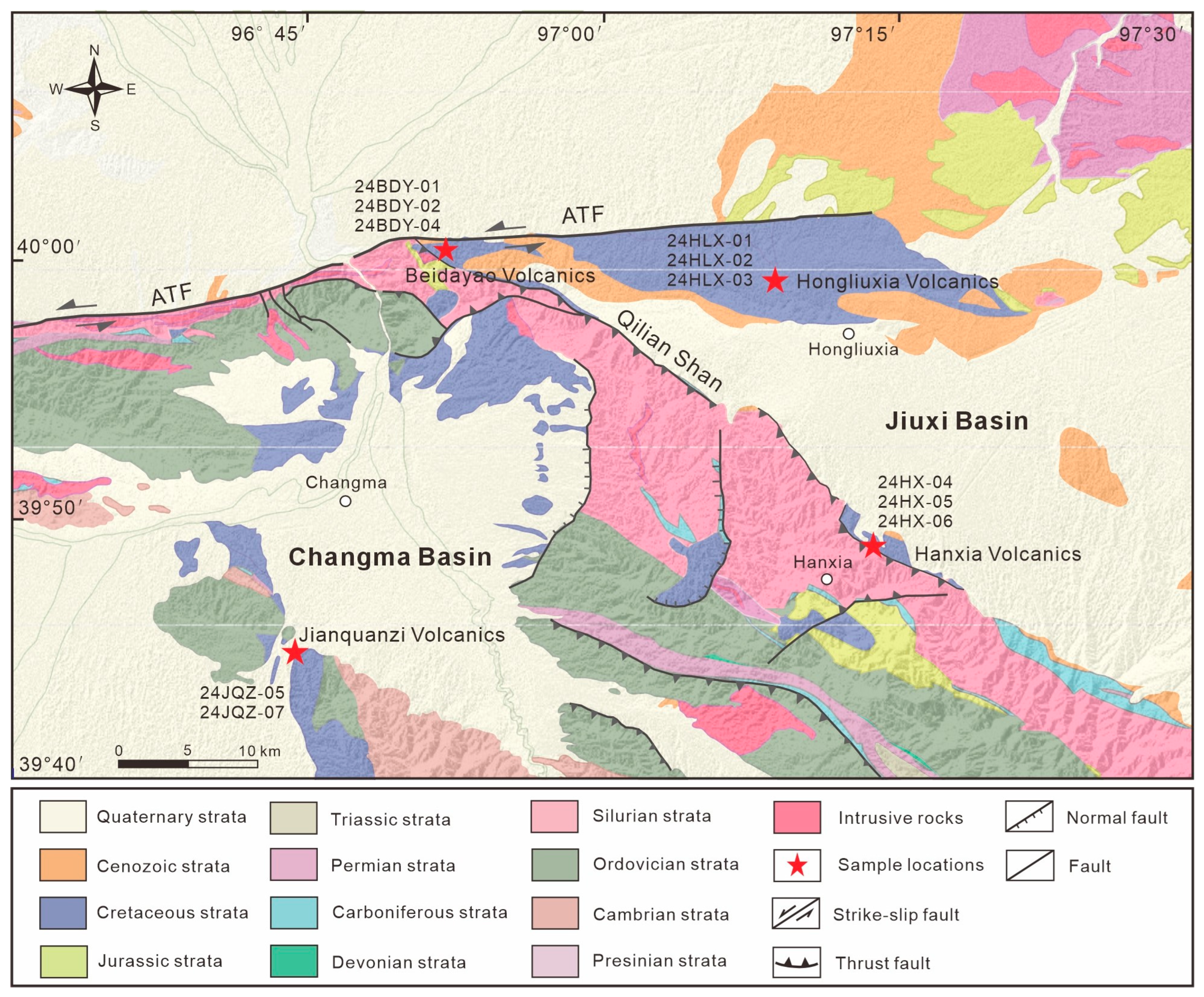
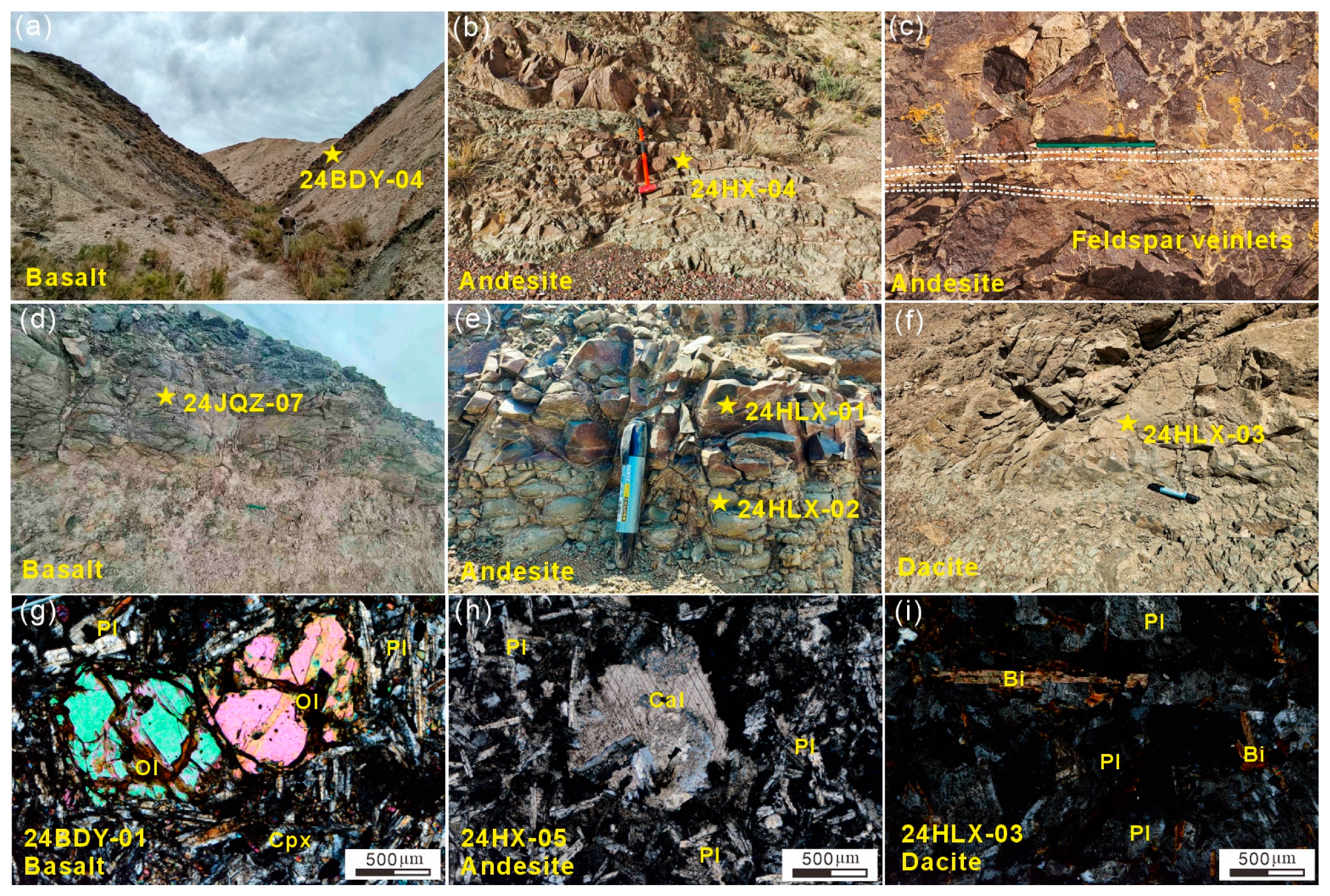

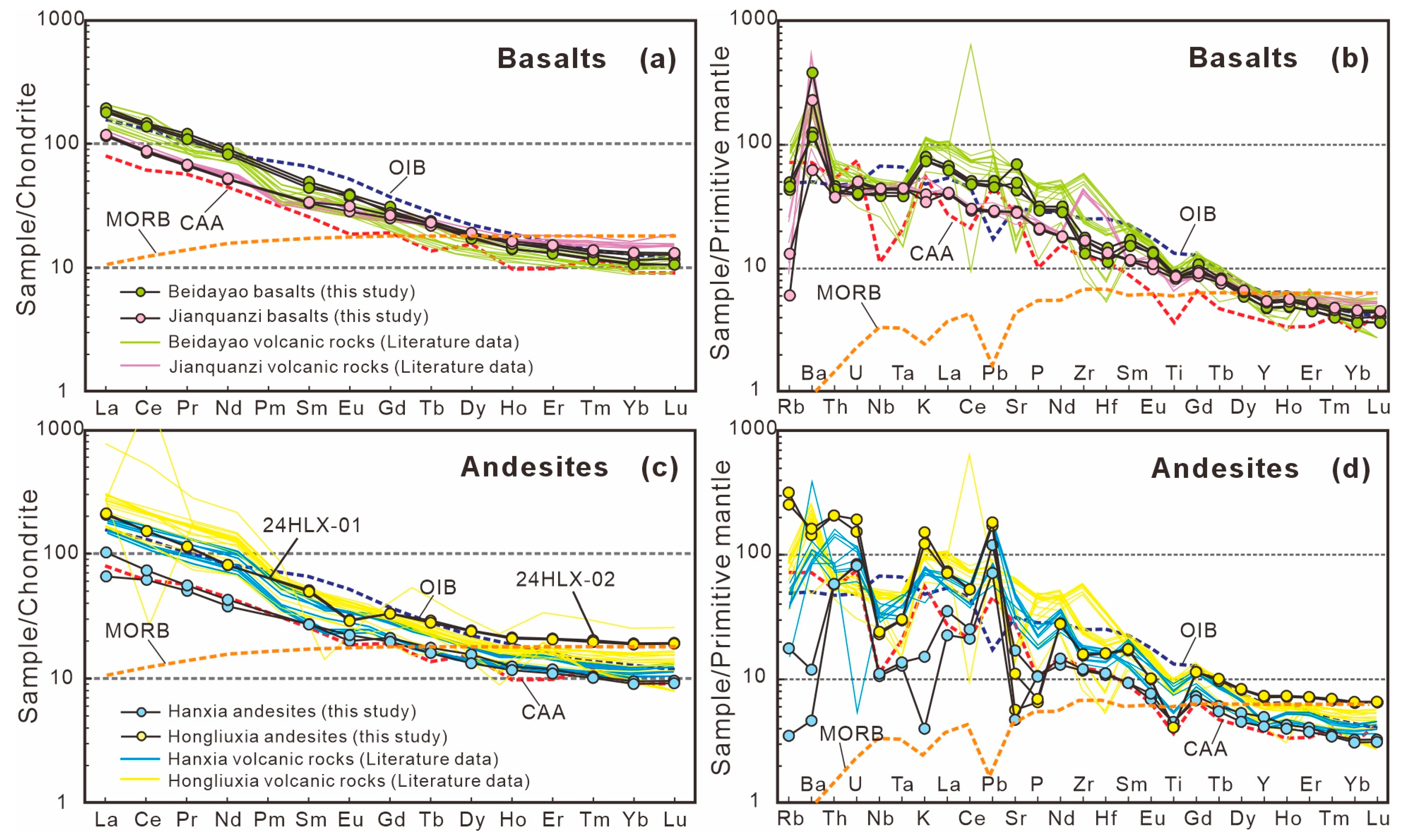
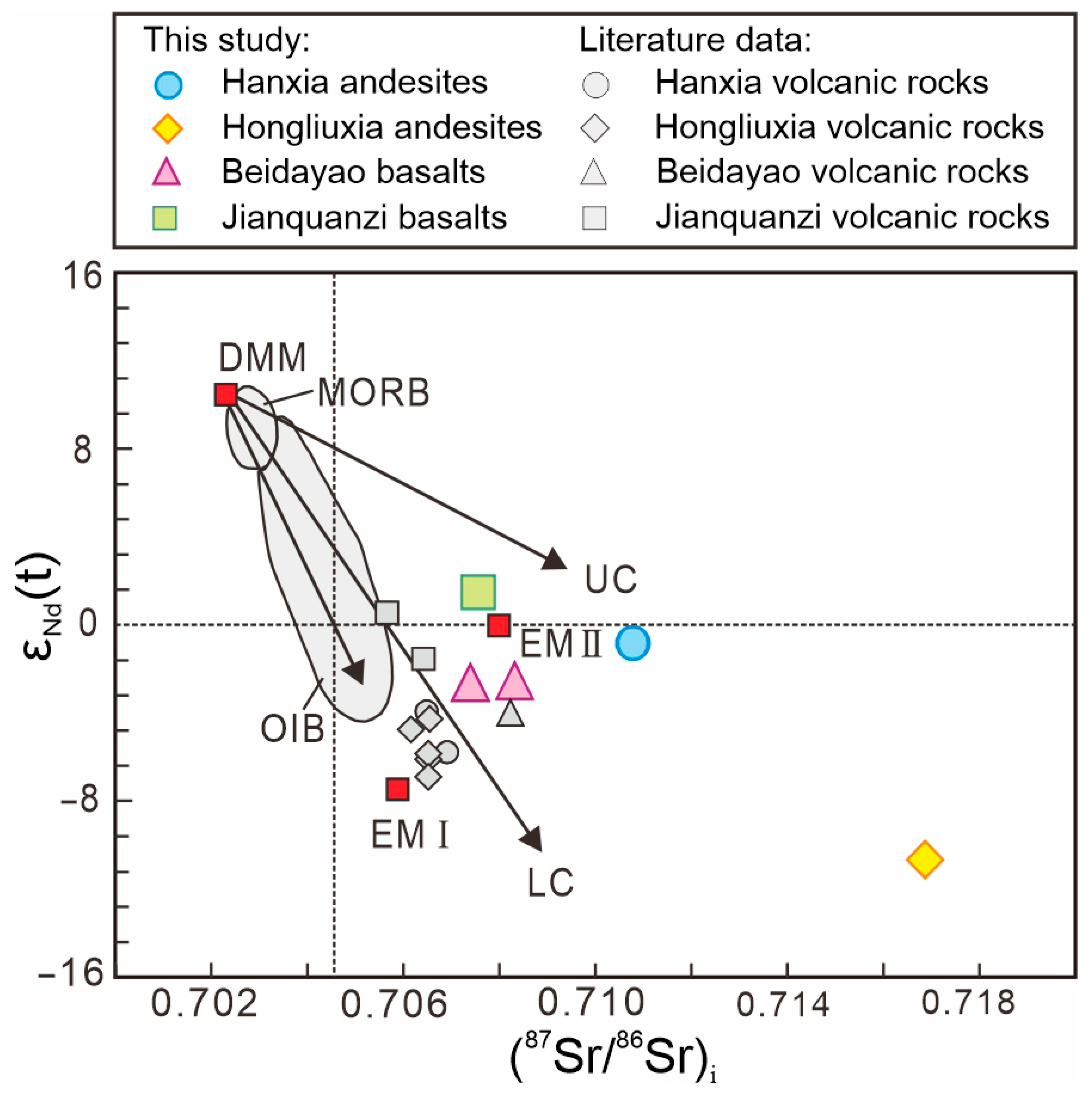


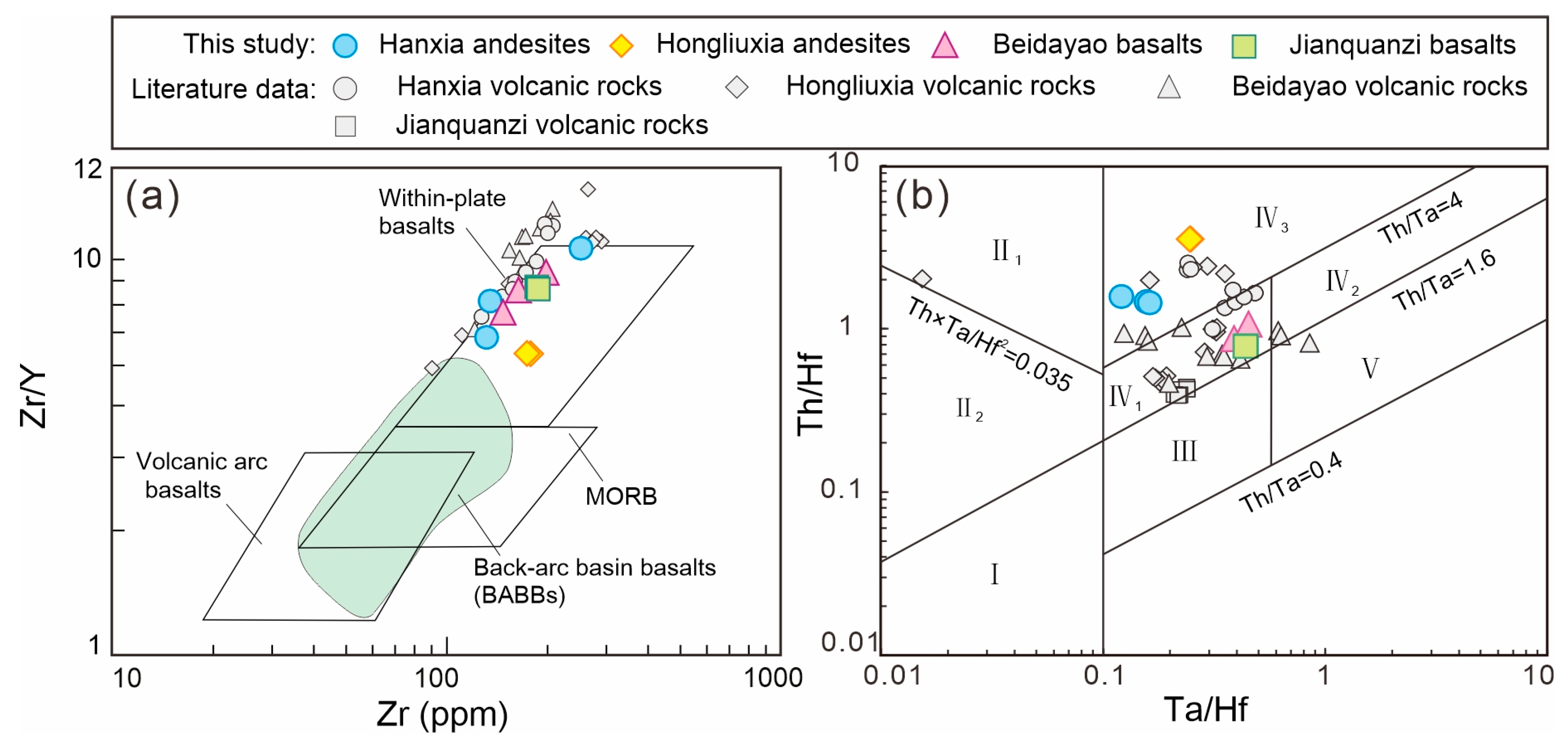
| Sample | Location | Lat. (°N) | Long. (°E) | Rock Type |
|---|---|---|---|---|
| 24HX-04 | ~20 km southeast of Hongliuxia | 39°48′41″ | 97°13′36″ | Andesite |
| 24HX-05 | ~20 km southeast of Hongliuxia | 39°48′40″ | 97°13′5″ | Andesite |
| 24HX-06 | ~20 km southeast of Hongliuxia | 39°48′40″ | 97°13′5″ | Andesite |
| 24HLX-01 | ~50 km south of Yumen City | 39°58′39″ | 97°09′30″ | Andesite |
| 24HLX-02 | ~50 km south of Yumen City | 39°58′39″ | 97°09′30″ | Andesite |
| 24HLX-03 | ~50 km south of Yumen City | 39°58′39″ | 97°09′30″ | Dacite |
| 24BDY-01 | ~20 km west of Hongliuxia | 40°0′53″ | 96°52′15″ | Basalt |
| 24BDY-02 | ~20 km west of Hongliuxia | 40°0′52″ | 96°52′12″ | Basalt |
| 24BDY-04 | ~20 km west of Hongliuxia | 40°0′47″ | 96°52′13″ | Basalt |
| 24JQZ-05 | ~10 km southwest of Changma Township | 39°45′8″ | 96°44′1″ | Basalt |
| 24JQZ-07 | ~10 km southwest of Changma Township | 39°45′8″ | 96°44′1″ | Basalt |
| Point No. | Element Contents (ppm) and Ratio | Isotope Ratio and Error | Age (Ma) and Error | Concordance (%) | ||||||||||||
|---|---|---|---|---|---|---|---|---|---|---|---|---|---|---|---|---|
| U | Th | Th/U | 207Pb/ 206Pb | 1σ | 207Pb/ 235U | 1σ | 206Pb/ 238U | 1σ | 207Pb/ 206Pb | 1σ | 207Pb/ 235U | 1σ | 206Pb/ 238U | 1σ | ||
| 24HLX-03 01 | 190 | 114 | 0.601 | 0.04170 | 0.00325 | 0.10117 | 0.00818 | 0.01734 | 0.00037 | −193 | 131 | 98 | 8 | 111 | 2 | 0.88 |
| 24HLX-03 02 | 509 | 473 | 0.929 | 0.05478 | 0.00079 | 0.53445 | 0.00822 | 0.07069 | 0.00040 | 403 | 24 | 435 | 5 | 440 | 2 | 0.99 |
| 24HLX-03 03 | 555 | 309 | 0.556 | 0.04961 | 0.00193 | 0.11432 | 0.00433 | 0.01695 | 0.00018 | 177 | 69 | 110 | 4 | 108 | 1 | 1.02 |
| 24HLX-03 04 | 258 | 114 | 0.441 | 0.04800 | 0.00254 | 0.10786 | 0.00538 | 0.01661 | 0.00023 | 99 | 86 | 104 | 5 | 106 | 1 | 0.98 |
| 24HLX-03 05 | 815 | 349 | 0.428 | 0.04669 | 0.00100 | 0.10632 | 0.00207 | 0.01682 | 0.00016 | 33 | 28 | 103 | 2 | 108 | 1 | 0.95 |
| 24HLX-03 06 | 100 | 117 | 1.172 | 0.05155 | 0.00373 | 0.11147 | 0.00744 | 0.01657 | 0.00032 | 266 | 117 | 107 | 7 | 106 | 2 | 1.01 |
| 24HLX-03 07 | 241 | 103 | 0.428 | 0.05440 | 0.00378 | 0.12162 | 0.00758 | 0.01686 | 0.00032 | 388 | 106 | 117 | 7 | 108 | 2 | 1.08 |
| 24HLX-03 08 | 107 | 120 | 1.121 | 0.05233 | 0.00385 | 0.11900 | 0.00887 | 0.01668 | 0.00028 | 300 | 140 | 114 | 8 | 107 | 2 | 1.07 |
| 24HLX-03 09 | 201 | 160 | 0.796 | 0.04580 | 0.00255 | 0.10270 | 0.00560 | 0.01645 | 0.00018 | −12 | 95 | 99 | 5 | 105 | 1 | 0.94 |
| 24HLX-03 10 | 105 | 69 | 0.660 | 0.05681 | 0.00432 | 0.12599 | 0.00897 | 0.01662 | 0.00035 | 484 | 120 | 120 | 8 | 106 | 2 | 1.13 |
| 24HLX-03 11 | 348 | 101 | 0.290 | 0.05009 | 0.00218 | 0.11576 | 0.00495 | 0.01685 | 0.00018 | 199 | 80 | 111 | 5 | 108 | 1 | 1.03 |
| 24HLX-03 12 | 366 | 166 | 0.452 | 0.04836 | 0.00277 | 0.10926 | 0.00565 | 0.01693 | 0.00029 | 117 | 86 | 105 | 5 | 108 | 2 | 0.97 |
| 24HLX-03 13 | 452 | 454 | 1.006 | 0.04775 | 0.00180 | 0.10957 | 0.00405 | 0.01671 | 0.00015 | 87 | 67 | 106 | 4 | 106.9 | 1 | 0.99 |
| 24HLX-03 14 | 218 | 43 | 0.195 | 0.04819 | 0.00215 | 0.10858 | 0.00465 | 0.01631 | 0.00016 | 109 | 80 | 105 | 4 | 104.3 | 1 | 1.01 |
| 24HLX-03 15 | 500 | 61 | 0.122 | 0.07088 | 0.00070 | 1.50650 | 0.01524 | 0.15338 | 0.00084 | 954 | 12 | 933 | 6 | 920 | 5 | 1.01 |
| 24HLX-03 16 | 115 | 79 | 0.685 | 0.05232 | 0.00312 | 0.11724 | 0.00658 | 0.01665 | 0.00030 | 299 | 95 | 113 | 6 | 106 | 2 | 1.07 |
| 24HLX-03 17 | 220 | 187 | 0.851 | 0.05376 | 0.00235 | 0.12119 | 0.00493 | 0.01679 | 0.00023 | 361 | 67 | 116 | 4 | 107 | 1 | 1.08 |
| 24HLX-03 18 | 132 | 75 | 0.568 | 0.04786 | 0.00278 | 0.11116 | 0.00641 | 0.01668 | 0.00024 | 93 | 101 | 107 | 6 | 107 | 2 | 1.00 |
| 24HLX-03 19 | 308 | 192 | 0.622 | 0.05092 | 0.00226 | 0.11811 | 0.00532 | 0.01653 | 0.00018 | 237 | 84 | 113 | 5 | 106 | 1 | 1.07 |
| 24HLX-03 20 | 453 | 201 | 0.443 | 0.04861 | 0.00191 | 0.12082 | 0.00429 | 0.01830 | 0.00020 | 129 | 63 | 116 | 4 | 117 | 1 | 0.99 |
| Sample | 24HX-04 | 24HX-05 | 24HX-06 | 24HLX-01 | 24HLX-02 | 24BDY-01 | 24BDY-02 | 24BDY-04 | 24JQZ-05 | 24JQZ-07 |
|---|---|---|---|---|---|---|---|---|---|---|
| Rock Type | Andesite | Andesite | Andesite | Andesite | Andesite | Basalt | Basalt | Basalt | Basalt | Basalt |
| Major elements (wt.%) | ||||||||||
| SiO2 | 62.79 | 55.79 | 57.73 | 61.83 | 61.14 | 48.40 | 49.64 | 48.35 | 47.67 | 47.95 |
| TiO2 | 0.54 | 0.92 | 0.94 | 0.86 | 0.85 | 1.76 | 1.84 | 1.75 | 1.74 | 1.78 |
| Al2O3 | 9.20 | 15.00 | 15.26 | 18.14 | 18.47 | 14.77 | 15.89 | 14.43 | 15.18 | 15.59 |
| Fe2O3T | 3.60 | 5.72 | 6.64 | 6.62 | 6.22 | 10.19 | 9.19 | 10.34 | 10.73 | 10.45 |
| MnO | 0.10 | 0.13 | 0.15 | 0.18 | 0.14 | 0.14 | 0.12 | 0.14 | 0.15 | 0.11 |
| MgO | 2.63 | 4.89 | 6.68 | 2.63 | 2.39 | 8.03 | 7.11 | 8.78 | 8.36 | 6.81 |
| CaO | 8.97 | 4.95 | 2.47 | 1.31 | 0.91 | 7.78 | 7.41 | 7.90 | 8.52 | 8.83 |
| Na2O | 1.98 | 6.67 | 4.86 | 1.25 | 1.30 | 3.34 | 3.13 | 3.07 | 3.57 | 3.54 |
| K2O | 1.28 | 0.11 | 0.44 | 3.57 | 4.36 | 2.16 | 2.32 | 2.15 | 1.16 | 0.99 |
| P2O5 | 0.16 | 0.22 | 0.22 | 0.15 | 0.14 | 0.63 | 0.67 | 0.62 | 0.43 | 0.44 |
| LOI | 8.83 | 5.89 | 5.05 | 3.01 | 3.80 | 2.30 | 2.11 | 1.80 | 2.35 | 2.83 |
| Total | 100.10 | 100.29 | 100.43 | 99.55 | 99.73 | 99.50 | 99.43 | 99.31 | 99.86 | 99.32 |
| Trace elements (ppm) | ||||||||||
| Li | 29.2 | 40.6 | 71.2 | 188 | 93.1 | 11.8 | 18.6 | 11.4 | 16.3 | 23.5 |
| Be | 1.29 | 0.95 | 1.13 | 2.82 | 3.20 | 1.76 | 2.18 | 1.68 | 1.77 | 1.76 |
| Sc | 8.98 | 19.1 | 18.2 | 20.6 | 20.3 | 23.0 | 24.7 | 23.6 | 24.6 | 25.7 |
| V | 60.5 | 115 | 136 | 135 | 135 | 174 | 180 | 166 | 165 | 173 |
| Cr | 89.0 | 220 | 220 | 120 | 116 | 256 | 223 | 269 | 243 | 255 |
| Co | 12.0 | 23.9 | 27.3 | 24.8 | 23.5 | 41.8 | 37.6 | 41.8 | 42.1 | 43.1 |
| Ni | 37.0 | 124 | 132 | 58.1 | 56.3 | 128 | 104 | 136 | 146 | 152 |
| Cu | 23.7 | 265 | 60.3 | 60.0 | 56.4 | 46.2 | 46.8 | 44.4 | 56.8 | 65.0 |
| Zn | 47.4 | 91.9 | 93.7 | 93.5 | 97.3 | 91.1 | 88.7 | 89.6 | 78.5 | 81.3 |
| Ga | 10.9 | 17.3 | 17.1 | 23.6 | 24.3 | 18.5 | 20.9 | 18.0 | 17.6 | 18.4 |
| Rb | 57.1 | 2.22 | 11.2 | 162 | 201 | 27.2 | 31.3 | 28.9 | 8.29 | 3.82 |
| Sr | 164 | 99.2 | 358 | 233 | 119 | 1454 | 896 | 1035 | 604 | 590 |
| Y | 26.3 | 22.5 | 18.9 | 33.4 | 32.4 | 21.5 | 23.6 | 21.9 | 24.0 | 24.6 |
| Zr | 252 | 131 | 135 | 178 | 173 | 163 | 197 | 147 | 185 | 188 |
| Nb | 10.8 | 7.55 | 7.89 | 17.2 | 16.4 | 29.0 | 31.3 | 27.2 | 30.5 | 31.3 |
| Sn | 1.76 | 1.23 | 1.26 | 3.86 | 3.17 | 1.55 | 1.62 | 1.45 | 1.70 | 1.76 |
| Cs | 4.08 | 0.97 | 2.12 | 7.75 | 5.34 | 0.86 | 0.29 | 0.62 | 5.62 | 6.04 |
| Ba | 447 | 32.3 | 83.3 | 1134 | 1004 | 870 | 805 | 2651 | 433 | 1588 |
| La | 29.2 | 15.5 | 24.2 | 48.8 | 50.1 | 43.6 | 45.8 | 42.4 | 27.3 | 27.9 |
| Ce | 56.3 | 37.6 | 44.8 | 93.2 | 93.3 | 87.1 | 89.7 | 84.3 | 51.8 | 53.6 |
| Pr | 6.91 | 4.76 | 5.26 | 10.8 | 10.9 | 10.8 | 11.4 | 10.3 | 6.27 | 6.43 |
| Nd | 25.2 | 17.6 | 19.8 | 37.6 | 37.9 | 40.1 | 42.5 | 38.3 | 24.0 | 24.4 |
| Sm | 5.28 | 4.16 | 4.13 | 7.75 | 7.53 | 7.11 | 7.54 | 6.71 | 5.06 | 5.16 |
| Eu | 1.15 | 1.15 | 1.29 | 1.70 | 1.67 | 2.15 | 2.27 | 2.22 | 1.65 | 1.82 |
| Gd | 5.03 | 4.32 | 4.03 | 6.79 | 6.79 | 5.94 | 6.38 | 5.67 | 5.14 | 5.44 |
| Tb | 0.80 | 0.66 | 0.59 | 1.09 | 1.04 | 0.84 | 0.89 | 0.84 | 0.81 | 0.86 |
| Dy | 4.67 | 3.93 | 3.34 | 6.13 | 6.04 | 4.48 | 4.77 | 4.33 | 4.71 | 4.85 |
| Ho | 0.91 | 0.70 | 0.65 | 1.20 | 1.18 | 0.79 | 0.88 | 0.81 | 0.88 | 0.92 |
| Er | 2.55 | 1.95 | 1.80 | 3.45 | 3.39 | 2.18 | 2.34 | 2.15 | 2.45 | 2.52 |
| Tm | 0.38 | 0.26 | 0.26 | 0.51 | 0.50 | 0.30 | 0.32 | 0.29 | 0.34 | 0.35 |
| Yb | 2.33 | 1.60 | 1.52 | 3.24 | 3.17 | 1.83 | 1.95 | 1.80 | 2.16 | 2.24 |
| Lu | 0.35 | 0.24 | 0.23 | 0.49 | 0.48 | 0.27 | 0.30 | 0.27 | 0.32 | 0.33 |
| Hf | 6.76 | 3.34 | 3.44 | 4.99 | 4.95 | 3.88 | 4.50 | 3.46 | 4.05 | 4.12 |
| Ta | 0.82 | 0.53 | 0.56 | 1.24 | 1.22 | 1.66 | 1.75 | 1.56 | 1.78 | 1.81 |
| Tl | 0.30 | 0.025 | 0.096 | 0.83 | 0.88 | 0.10 | 0.081 | 0.086 | 0.019 | 0.015 |
| Pb | 12.0 | 13.2 | 22.2 | 33.8 | 31.6 | 8.56 | 9.33 | 8.32 | 5.26 | 5.38 |
| Th | 10.6 | 4.89 | 4.94 | 17.7 | 17.5 | 3.46 | 3.90 | 3.68 | 3.16 | 3.20 |
| U | 2.68 | 1.76 | 1.71 | 4.05 | 3.21 | 0.82 | 0.92 | 0.84 | 1.02 | 1.05 |
| Nb/Y | 0.41 | 0.33 | 0.42 | 0.51 | 0.51 | 1.35 | 1.33 | 1.25 | 1.27 | 1.27 |
| Nb/U | 4.03 | 4.28 | 4.61 | 4.24 | 5.11 | 35.42 | 33.98 | 32.48 | 29.80 | 29.80 |
| Sr/Y | 6.21 | 4.40 | 18.98 | 6.99 | 3.68 | 67.48 | 37.99 | 47.30 | 25.10 | 23.97 |
| (La/Yb)N | 9.00 | 6.96 | 11.41 | 10.83 | 11.34 | 17.10 | 16.82 | 16.95 | 9.07 | 8.93 |
| Sample | Age (Ga) | Sm (ppm) | Nd (ppm) | 147Sm /144Nd | 143Nd /144Nd | Error (2s) | (143Nd/ 144Nd)i | εNd (t) | tDM2 (Ga) | Rb (ppm) | Sr (ppm) | 87Rb /86Sr | 87Sr /86Sr | Error (2s) | (87Sr/86Sr)i |
|---|---|---|---|---|---|---|---|---|---|---|---|---|---|---|---|
| 24HX-06 | 0.120 | 4.13 | 19.8 | 0.126 | 0.512504 | 0.000006 | 0.512405 | −1.5 | 1.0 | 11.2 | 358 | 0.091 | 0.709976 | 0.000006 | 0.70982 |
| 24HLX-01 | 0.112 | 7.75 | 37.6 | 0.124 | 0.512005 | 0.000005 | 0.511914 | −11.3 | 1.8 | 162 | 233 | 2.006 | 0.719777 | 0.000006 | 0.71658 |
| 24BDY-02 | 0.117 | 7.54 | 42.5 | 0.107 | 0.512400 | 0.000005 | 0.512318 | −3.3 | 1.2 | 31.3 | 896 | 0.101 | 0.706223 | 0.000007 | 0.70605 |
| 24BDY-04 | 0.117 | 6.71 | 38.3 | 0.106 | 0.512403 | 0.000004 | 0.512322 | −3.2 | 1.2 | 28.9 | 1035 | 0.081 | 0.707219 | 0.000008 | 0.70708 |
| 24JQZ-05 | 0.118 | 5.06 | 24.0 | 0.127 | 0.512625 | 0.000007 | 0.512527 | 0.8 | 0.9 | 8.29 | 604 | 0.040 | 0.706311 | 0.000010 | 0.70624 |
Disclaimer/Publisher’s Note: The statements, opinions and data contained in all publications are solely those of the individual author(s) and contributor(s) and not of MDPI and/or the editor(s). MDPI and/or the editor(s) disclaim responsibility for any injury to people or property resulting from any ideas, methods, instructions or products referred to in the content. |
© 2025 by the authors. Licensee MDPI, Basel, Switzerland. This article is an open access article distributed under the terms and conditions of the Creative Commons Attribution (CC BY) license (https://creativecommons.org/licenses/by/4.0/).
Share and Cite
Qin, L.-Q.; Bai, Y.; An, Y.; Wang, J.-L.; Ma, Y.-Y.; Lu, H.-X.; Luo, Y.-H. The Early Cretaceous High-Nb Basalt and Arc Andesite Association in the Eastern Segment of the Altyn Tagh Fault: Petrological Records of Intracontinental Extension. Minerals 2025, 15, 1103. https://doi.org/10.3390/min15111103
Qin L-Q, Bai Y, An Y, Wang J-L, Ma Y-Y, Lu H-X, Luo Y-H. The Early Cretaceous High-Nb Basalt and Arc Andesite Association in the Eastern Segment of the Altyn Tagh Fault: Petrological Records of Intracontinental Extension. Minerals. 2025; 15(11):1103. https://doi.org/10.3390/min15111103
Chicago/Turabian StyleQin, Lu-Qing, Yong Bai, Yu An, Jin-Lin Wang, Ying-Ying Ma, Hai-Xin Lu, and Yu-Hang Luo. 2025. "The Early Cretaceous High-Nb Basalt and Arc Andesite Association in the Eastern Segment of the Altyn Tagh Fault: Petrological Records of Intracontinental Extension" Minerals 15, no. 11: 1103. https://doi.org/10.3390/min15111103
APA StyleQin, L.-Q., Bai, Y., An, Y., Wang, J.-L., Ma, Y.-Y., Lu, H.-X., & Luo, Y.-H. (2025). The Early Cretaceous High-Nb Basalt and Arc Andesite Association in the Eastern Segment of the Altyn Tagh Fault: Petrological Records of Intracontinental Extension. Minerals, 15(11), 1103. https://doi.org/10.3390/min15111103





